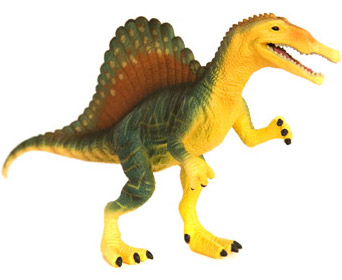Tiny Vertebra Re-writes the History of Australian Dinosaurs
Australia’s First Spinosaur
Spinosaurids are a group of carnivorous dinosaurs that flourished during the Early Cretaceous. These creatures, with their distinctive crocodile-like, kinked jaws are believed by scientists to have been specialised fish-eaters. No fossil of a spinosaur had ever been found in Australia, suggesting that these dinosaurs did not make up part of the mega fauna of that continent. However, the discovery of a tiny, fossil bone in 2005 and a paper published in the scientific journal “Biology Letters” suggest that spinosaurids did live “down under”. Is it time to re-write the history of Australian dinosaurs.
Australian Dinosaurs
A number of carnivorous dinosaurs are known from Australia, in 2007, near the town of Inverloch scientists from the Monash University reported upon the discovery of distinctive three-toed dinosaur footprints – a trace fossil of a meat-eating dinosaur (theropod) that had been found in strata dating from approximately 115 million years ago. An ankle bone, found in the Otway Range, near Melbourne suggests the presence of allosaurs on the land that was to become the isolated continent of Australia and in the rocks surrounding the town of Winton, a new, agile theropod dinosaur was discovered two years ago. This dinosaur was named A. wintonensis and has been described as “the Cheetah of its day” by Australian palaeontologists.
To read about the discovery of meat-eating dinosaur footprints: Meat-eating Dinosaur Footprints discovered in Australia.
To read more about A. wintonensis: A Trio of Dinosaurs from Down Under.
This new discovery, that of the fossilised neck vertebra (cervical vertebra) suggests that spinosaurs were present in the area that was to become Australia. No evidence of these type of meat-eating dinosaurs has been found in Australia before. This suggests that the land bridge between Australia and South America (where a number of spinosaurid fossils have been discovered) may not have been broken as early in the geological record as previously thought.
To read an article on the changing theories relating to land bridges on Gondwanaland: Dinosaur Discovery “Knocks” Continental Drift.
Some scientists believe that African species of spinosaur were the largest meat-eating dinosaurs that ever lived, with lengths in excess of sixty feet being claimed. Unfortunately, these fossils found by a German led expedition to North Africa were destroyed in WWII.
An Illustration of a Model Giant Spinosaur (S. aegyptiacus)

Picture credit: Everything Dinosaur
Researchers from London’s Natural History Museum, the University of Cambridge, Museum Victoria and Monash University were thrilled when they were able to identify the fossil.
Commenting on the discovery, Dr Thomas Rich, an eminent palaeontologist, who has discovered a number of new Australian dinosaurs himself stated:
“Spinosaurs were previously known to be from Europe, Africa and South America. The fact that they existed in Australia changes our understanding of the evolution of this group of dinosaurs.”
The tiny, vertebra fossil was discovered by Michael Cleeland and George Caspar near Victoria’s Cape Otway Lighthouse in 2005. It was then painstakingly prepared at Museum Victoria until it could be identified as Australia’s first-ever member of the Spinosauridae. The researchers was able to deduce the neck vertebra belonged to a small juvenile, around two metres long, which lived 105 million years ago (Albian faunal stage).
But another co-author on the paper on this new dinosaur, Professor Patricia Vickers-Rich, palaeontologist at Monash University, says it isn’t possible to draw conclusions about the type of newly announced spinosaur, whether it was male or female or its body structure when there is only a 4 centimetre neck vertebra to go by. These details can only be fleshed out if more spinosaur fossils are discovered.
At the time the spinosaur lived, Australia was not an isolated landmass, making it easier for dinosaurs to move around.
Explaining the impact of continental drift on dinosaur distribution a spokesperson commented:
“When the Earth evolved into separate continents, the various families of dinosaurs had already reached those landmasses, which explains why the same ones have been found in places now far apart from one another.”
Patricia says this challenges the idea an endemic fauna was present in Australia 110-120 million years ago.
She believes there could be many more dinosaur groups still to be discovered in Australia and certainly from the evidence so far, with lots of new dinosaur discoveries having already been made – she is probably on the right track (should that be a three-toed track)?
Discussing the problems of finding dinosaur fossils in Australia, Professor Patricia Vickers-Rich stated:
“The record is so sparse and these fossils are so difficult to find. Every bone has the chance to be something different, [this vertebra] could have been from something more common, but spinosaurs are carnivores, which are usually very rare in population.”
For models and replicas of Australian dinosaurs and other prehistoric creatures: Dinosaur and Prehistoric Animal Models.

